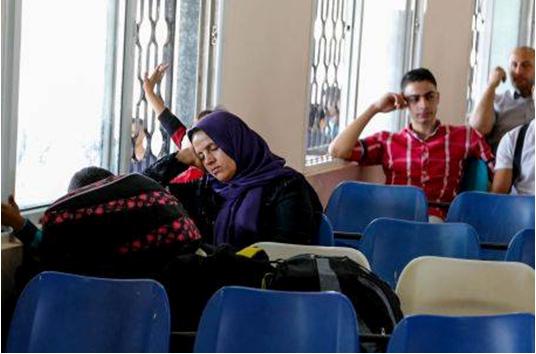Five months have passed since the Rafah Crossing, controlled by Egypt, was last open to persons exiting from the Gaza Strip. This is the longest consecutive stretch of time the crossing has been closed for Gazans seeking to travel abroad since 2007.
The names of approximately 30,000 Gaza residents meeting Egyptian criteria for travel appear on a waiting list to exit to Egypt. Usually such permits are issued to transfer to a third country: students hoping to study abroad, business people and traders, medical patients with referrals for treatment in hospitals, immigrants, people who wish to visit their relatives, etc.
When Rafah Crossing was open daily, up until mid-2013, an average of 40,000 persons would pass through in either direction per month, individuals who met the restricted criteria for permits. In the absence of the option of exiting Gaza through Rafah, the only remaining gateway between Gaza and the rest of the world is Erez Crossing, controlled by Israel. The number of exits from Gaza via Erez has also dropped dramatically, to about half of the monthly average of exits recorded during 2016. This trend contradicts what has been implied in repeated statements by Israeli military and governmental officials, who like to pay lip service to the importance of improving living conditions in the Strip.
After a decade of closure which has entirely failed in achieving its objectives, and even after Israel announced its intention to ease restrictions on exiting and entering Gaza, freedom of movement for residents of Gaza has only worsened and the closure has only tightened. Israel’s permit regime, along with Egypt’s policy at Rafah Crossing, and a series of politically motivated steps by the Palestinian Authority (PA) to increase pressure on the population of Gaza – including reducing the electricity supply to the strip, cutting the salaries of thousands of PA employees in the Strip and forcing thousands more into early retirement – continue to significantly impair the lives of residents, who face many adversities as it is.
According to Gisha, an Israeli NGO focusing on the freedom of movement for Palestinians, “Two million people, 42% of whom are under the age of 15, live in the Gaza Strip. They deserve a chance at a decent life, as we all do. All parties with power and influence in the region must differentiate between their political motivations and the rights of Gaza residents to live in dignity. Arbitrary restrictions on freedom of movement can and must be removed immediately.”
In addition, Gisha’s legal department sent a letter of protest to the head of the Gaza Civil Liaison Administration (CLA), Colonel Fares Atilla, after receiving reports from the NGO’s intake coordinators. According to these reports, Gaza residents traveling abroad via Erez Crossing confirmed a relatively new practice imposed on the Israeli side of the crossing, by which, at the very last minute, they were forced to sign a waiver, committing themselves not return to Gaza for at least a year, as a condition for being allowed to depart on their journeys.
In February 2016, The Gaza CLA introduced this draconian demand as a prerequisite for receiving an exit permit, particularly in the case of residents applying for exit permits for lengthier periods of time. On July 25 of this year, scores of Gaza residents, whose exit from the enclave had already been approved, and who were on their way to travel abroad, were detained at Erez Crossing until they signed the waiver. It was made clear to the residents that signing the commitment was a condition for boarding the shuttle to the Allenby Bridge, and from there to Jordan, and that those who did not sign would have to return to Gaza.
Related:



